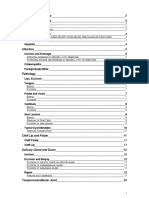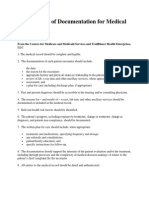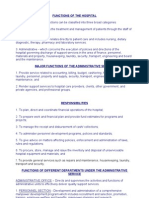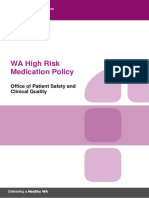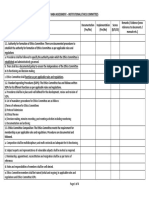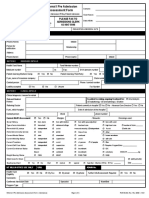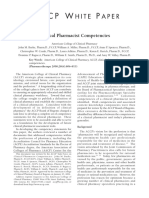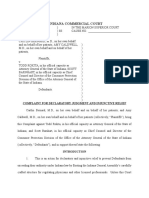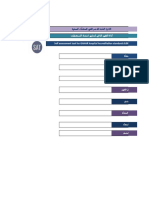Professional Documents
Culture Documents
Importance of Effective Clinical Documentation by Medical Doctors To Patient Care Management in Federal Teaching Hospital, Ido Ekiti, Ekiti State, Nigeria
Original Title
Copyright
Available Formats
Share this document
Did you find this document useful?
Is this content inappropriate?
Report this DocumentCopyright:
Available Formats
Importance of Effective Clinical Documentation by Medical Doctors To Patient Care Management in Federal Teaching Hospital, Ido Ekiti, Ekiti State, Nigeria
Copyright:
Available Formats
Volume 5, Issue 7, July – 2020 International Journal of Innovative Science and Research Technology
ISSN No:-2456-2165
Importance of Effective Clinical
Documentation by Medical Doctors to Patient Care
Management in Federal Teaching Hospital,
`Ido Ekiti, Ekiti State, Nigeria
Ogbona Mary Aina1 , Ayodele Kolawole Musa2 , 3Ojo Phebian Opeyemi
1-2
Department of Health Information Management, College Of Health Sciences and Technology, Ijero-Ekiti, Ekiti State, Nigeria.
3
Department of Computer Science, College of Health Sciences and Technology, Ijero-Ekiti. Ekiti –State, Nigeria
Abstract:- This study scrutinized clinical documentation I. INTRODUCTION
by medical doctors as a factor affecting patient care
management and goes a long way to determine the quality Clinical documentation (DC) is the invention of digital
of care given to patients in Federal Teaching Hospital, Ido or analogue record detailing a medical treatment, medical trail
- Ekiti Nigeria. The study adopted descriptive survey or clinical test. Clinical documentation is a vital legal and
research design by administering questionnaire to professional requirement for all health practitioners. Suitable
respondents. The result disclosed that larger percentage of documentation enhances patients’ interpersonal relation
respondents agreed that the objectives of clinical through a well fostered information to all members of the
documentation in patient care management are to health care system and this is equally pertinent to ensure
acquiesce with legal regulatory and institutional holistic patient care management. When clinical
requirements that will assure compliance with clinical documentation improvement (CDI) was first introduced in the
documentation Moreover, the result shows that, greater United States (US), the policy climate of the Bush
number of the doctors consented that adherence to policy administration, with a major focus on increasing the
procedure with maen=1.80 and SD=0.45 is the level of effectiveness of hospital care and reducing the cost of the
blunders that are the most practised in clinical healthcare system. The Deficit Reduction Act 2005 was a
documention guideline/standard in the health combination of withholding reimbursement (for hospital
institution ,while those that are less practised in the health acquired conditions), giving some mandatory indicators
institutions are medical history, medical follow up, drug (“Present on Admission” flags) and incentivizing best practice
administration and proper diagnosis with (×=1.40, (through “value-based purchasing”) [1]
SD=0.55). It was also discovered from the result that the
use of clinical documentation aids in continuity of Clinical documentation involves the capturing and
evaluation of patient 95.5%, the use of accurate clinical recording that is effective and credible to produce trusted
documentation can help reduce errors 95.4%. Majority of record of care that is capable of providing complete and
respondents agreed that, the use of clinical documentation important details about the patient. The existence of clinical
provides a basis for follow-up.In addition, the result documentation over the years has made a significant progress
signifies that the most areas of blunders in clinical on health record in the sector [2]. The need for clinical
documentation in the health institutions are of documentation has brought about active clinical note taking
disparaging remarks with mean of 2.80 and support to practitioners, the accurate recording of all events
SD=0.45.Lastly, the result points out that the perception of within a consultation including diagnosis, procedures and
clinical documentation has a temperate significant management of patient information.
relationship with patient care management N=450,
r=.363**, p <.05. This implies that the level of doctor's It is expedient for Healthcare providers and provider
perceptions of clinical documentation have the propensity organization by local policy, regulation and law to retain
to increase the level of patient care management in the documentation of care that has been provided for specific time
health institution. periods, however, this appear a deficient as it did not has
significant effects on many health organizations considering
Keywords:- Clinical Documentation; Health Care; Medical the level of record that is involved. However, the
Records; Physicians; Patient Care; Management; Nigeria. communication and continuity of care among physicians has
an implication on the patient other than health care
professionals involved in terms of their accuracy and
IJISRT20JUL264 www.ijisrt.com 462
Volume 5, Issue 7, July – 2020 International Journal of Innovative Science and Research Technology
ISSN No:-2456-2165
timelines. The review of quality clinical documentation in followed by the name, age, date of birth, address and contact
most of the hospitals have been evaluated to ensure information of the affected person [6]
that ,collection of data that may be useful for research and
education are made real. Also the accuracy of this Boone, 2011 [7] stated that there are two key functions
documentation on patient's records serves as a communication to Clinical document; they communicate relevant clinical
tool for all health personnel involved in the care of a patient information between health care providers separated by time
and is essential for medical and legal purposes [3]. or distance and support compliance with local policy,
regulation and law. Peculiar characteristics supporting these
In view of the this, health care systems, hospitals, functions are credibility and completeness,). A clinical
residency training programmes, medical schools, and patients Document must be credible to be effective. This implies that
all have an interest in ensuring physicians are practicing high- often times trusted authority produced it and is itself a trusted
quality clinical documentation for patient care management. record of care that was provided. Clinical documents should
[3]. also be complete records of care that do not leave out
important details. The judgment of what is relevant or
Wood, 2010 [4] opined that the importance of quality important within a clinical document at the time it was written
documentation on patient care management cannot be is left to the trusted authorities that produce them.
overemphasised as it provides information for optima health
records of a patient in acute care hospital. Equally, effective Clinical documentation is a process of recording and
documentation enhances professional capacity care, right communicating a written rationale of intervention, and as such
judgement, and critical assessment as related to the provision becomes an integral part of the patient medical record. It
of patient care. involves a comprehensive assessment, identified problems,
expected outcomes, Tahoe plan of care and care delivered (or
This serves as fundamental part of clinical practice and it not delivered); advice sought in decision making, and the
demonstrates the clinicians’ accountability and records their patient's response to treatment, discharge and plans for on-
professional practice. Documentation in medical records going care.
facilitates diagnosis and treatment, pertinent information to
other caregivers to ensure patient safety and reduce medical In all, it is worthy to say that Clinical documentation is a
errors and serves an important medico-legal function in risk process of recording and communicating a written rationale of
management. intervention, and as such becomes an integral part of the
patient medical record. It involves a comprehensive
Tower, 2013 [5] maintained that clinical documentation assessment, identified problems, expected outcomes, Tahoe
is critical for patient’s care management because it presents plan of care and care delivered (or not delivered); advice
the process and actions involved towards achieving efficient sought in decision' making, and the patient's response to
and quality patient care. treatment, discharge and plans for ongoing care.
Also, clinical documentation ensures certainty in Baird (2009) [8] opined that, clinical Documentation or
patient’s care management because whatever that is recorded source document/documentation referred to by the coder
will be guiding physician in furthering patients’ care. should describe the patient's condition using terminology that
includes specific diagnosis, as well as symptoms, problems, or
Also, any entry in clinical documentation should not be reasons for the service. Clinical document tells a story about
reduced in a careless manner and using any such materials care being provided to a patient. Like any other story, the
such as correction ink, eraser, liquid paper, and the like. Any clinical Document has a particular setting in space and time
overdue entry or supplemental entry should be indicated and a cast of character that the reader should understand in
separately together with the date and corresponding notes and order to make sense of what had been recorded. Okaisu et.al
signature. It is very important for any clinical documentation (2014) [9] observed that, it involves patients receiving
to be comprehensive in every respect and should follow all the diagnostic services only during an encounter/visit, coders are
standard rules and guidelines to avoid risks brought by reviewing the documentation for the diagnosis, condition,
noncompliance. In nutshell, a clinical documentation has problem, or other reason for encounter visit shown in the
every detail about the patient from the moment of admission medical record to be chiefly responsible for the outpatient
up to the release. There are specific rules that should be services during the encounter visit.
followed in keeping clinical documentation. The most
common is the correct recording of the patient's chief In other word, for patients receiving therapeutic services
complaint, The diagnosis and any procedures carried upon only during an encounter/visit, the coder is expected to review
indicating when, how, where, who performed it, date and time the medical record for the diagnosis, condition, problem, or
together with the authorized signature and also the official role other reason for his/her visit documented in the medical
of the professional involved. The record should also be record. Meaning that, he should be chiefly responsible for the
patient provided during the encounter/visit. Also, with
IJISRT20JUL264 www.ijisrt.com 463
Volume 5, Issue 7, July – 2020 International Journal of Innovative Science and Research Technology
ISSN No:-2456-2165
outpatient diagnostic service, there should be specific confusing, especially if pharmacist varies the placement of
guidelines and tips for the coders to follow to be in information from different sources. One example involves the
compliance with your policy [10]. In fact, it is observed that, placement of a patient's height, weight, and allergies. A
many single physician practices are sole proprietorship. The clinician may document this information in the subjective
legal distinction between the healthcare provider as a person field, while another one may place it in the objective field.
and the organization that they operate is virtually non-existent.
II. OBJECTIVES OF THE STUDY
According to Cradock , (2012) [11] documentation may
include written and electronic health records, audio and video The research aims to achieve the following objectives:
tapes, emails, facsimiles, images (photographs and diagrams), a. To assess the level of effectiveness of clinical
observation charts, check lists, communication books, documentation among medical doctors in Federal
shift/management reports, incident reports and clinical Teaching Hospital, Ido-Ekiti
anecdotal notes or personal reflection (held by the clinicians b. To identify the importance of clinical documentation to
personally or any other type or form of documentation patient management in Health Institution
pertaining to the care provided. Good patient care and health c. To determine the perceptions of medical doctors on
outcomes are dependent on accurate, clear, complete and clinical documentation in the hospital
timely documentation of a patient's diagnosis functional status,
interventions, problems, treatment and progress. Global III. METHODOLOGY
studies have shown that quality information contained within a
patient’s health record improves patient care and outcomes. The Research work was conducted at Federal Teaching
Hospital, Ido-Ekiti, a hospital of 300-bed capacity and the
only Federal Teaching Hospital in Ekiti State, Nigeria.
Other forms of documentation which are relevant to
evidence of clinical practice and of interest to the employer, a Descriptive survey research design was adopted for the
regulatory authority, the ministry of health, courts, funding study. Data was generated from the respondents on importance
bodies and the General public. These documentations are of effective clinical documentation to patient care
equally important in policies, procedures and protocols, management.
critical incident/occupational health and safety reports,
personnel file, performance appraisal, clinical assessments and The research design is concerned with the totality of the
published reports/papers. Documentation is the primary form plan used in executing a research study. It lays out the plan for
for which payers traditionally reimburse. Systematic investigation the research questions and details of the study
documentation should be used to demonstrate how pharmacist which flows from the specific questions asked. [14]
interventions improved patient care and should not just be
used for reimbursement. Documentation should be complete, All medical doctors were solicited to partake in the
complementary, compelling with supportive evidence, study. Thus, three hundred and twenty (320) questionnaire
standardized and systematic to complement oral were administerd in which three hundred (300) questionnaires
communication among providers [8]. were returned, yielding 93.75% response rate. According to
Sekaran (2000), [15] a response rate of thirty percent (30%) is
Brunero, & Stein-Parbury, (2011) [12] is of the opinion regarded as acceptable for most research purposes. This good
that documentation should reflect patient agreement with the response rate can be attributed an informed decision through
care plan among multiple providers in terms of medication personal interview of the respondents in which the purpose
reconciliation, data collection, continuity of care, and the and objectives of the research was well explained to the
transitioning of care. Practitioners should maintain treating respondents .
the patient in line with documentation and rather than
interpreting laboratory result. Diverse documentation methods The sample (n=320) comprised of males and females,
must be adopted to record pharmacist interventions, permanent doctors/physicians and contract employees
comprising unstructured notes, semi structured notes, and spanning across the following professional classes:
systematic records. Consultants/PhD, Senior Registrar, Registrar, House officers
and other medical doctors who are not specialized
Cranor, et.al (2013) [13] equally noted that
documentation should be clear concise, legible, non- Methods of Data Collection
judgmental, patient focused, and standardized, and it should Data collected was analysed using descriptive statistics.
ensure patient confidentiality. Also, in most cases, clinician The descriptive statistics was used to present details of the
record seems to be in professional capacity in relation to the demographics using frequencies, percentages, means and
provision of patient care. Systematic documentation provides standard deviations.
completeness, consistency, and organization. Documentation
without a systematic structure may be time consuming and
IJISRT20JUL264 www.ijisrt.com 464
Volume 5, Issue 7, July – 2020 International Journal of Innovative Science and Research Technology
ISSN No:-2456-2165
Ethical Consideration. Professional status frequency percentage
After the participants were duly informed of the purpose House officers 70 23.3
and users of the study, their right to either stay or withdraw Registrar 110 36.7
from the study and after assurances of utmost confidentiality Senior registrar 50 16.7
of data to be obtained, informed consent was received from Consultants 40 13.3
them. Professor 30 10.0
Total 300 100.0
IV. RESULTS AND DISCUSION Table 4:- Distribution of respondent by professional status
Demographic Information Table 4 presents A professional status of respondents.
The result shows that, Registrar has the highest frequency of
Age group Frequency percentage 110 (36.7%), followed by the house officers with 79 (23.3%),
20-29 years 56 18.7 senior registrars have 50 (16.7%), Consultants have 40
30-39 years 58 19.3 (13.3%) while professor constitutes the least with 30 (10.0%).
40-49 years 146 48.7 This therefore implies that majority of the respondents are
50yrs and above 40 13.3 registrar.
Total 300 100.0
Table 1:- Distribution of respondents by Age Year of cadre Frequency Percentage
1-5years 37 12.3
In the table 1 above, the result reveals that respondents 6-10years 145 48.3
age 40-49 years has the percentage of 48.7% while those at 11-15years 60 20.0
age level 30-39 years are 19.3% and those that are below 30 16-20years 41 13.7
years are 18.7% while those at above 50years constitute 21 above 17 5.7
13.3%. This shows that the majority of the respondents were Total 300 100.0
within 40-49 years age bracket. Table 5:- How long have you been in the cadre?
Gender Frequency Percentage The above result shows that 145 (48.3%) are within 6-
Male 180 60.0 10years in cadre, 60 (20.0%) were within 11-15years in cadre,
Female 120 40.0 41 (13.7%) were within 16 -20 years in cadre, 37 (12.3%)
Total 300 100.0 were within 1-5yrs while 21years above constitute the least
Table 2:- Distribution of respondents by gender with 17 (5.7%). This result implies that majority of the
respondents are within 6-10years in cadre.
Table 2 shows that 220 (73.3%) of the respondents
were male while 120 (40.0%) were female. It can be inferred Yes No
from the analysis that male constituted the greater majority of Manual health record 203 (67.7%) 97 (32.3%)
respondents. Electronic health record 214 (71.3%) 86 (28.7%)
Hybrid health record 218 (72.7%) 82 (27.3%)
Years of Frequency percentage Computerized medical record 208 (69.3%) 92 (30.7%)
practice Table 6: Do you use these types of health records in your
1-5 years 26 8.7 healthcare institution?
6-10 years 37 12.3
11-15 years 64 21.3 Type of health records being used in health care were
16-20 years 115 38.3 revealed in table 6. It was made evident that a larger
More than 20 58 19.3 percentage, 218 (72.7%) of the sampled population claimed
years hybrid health record, 214 (71.3%) claimed electronic health
Total 300 100.0 record, 208 (69.3%) claimed computerized medical record,
Table 3:- Distribution of respondents by Year of practice 203 (67.7%) claimed manual health record.
The distribution of the respondents by years of practice Frequency percentage
shows that 115 (38.3%) are within 16-20-years of practice; 64 Manual health record 50 16.7
(21.3%) were within 11-15yrs of practice, 58 (19.3%) were Electronic health record 154 51.3
within more than 20yrs, while 37 (12.7%) were within 6- Hybrid health record 96 32.0
10years while 1-5years constitute the least with 35 (8.7%). Total 300 100.0
This result implies that highest percentage of the respondents Table 7:- Which of these types of health records do you think
are within 16-20yrs in practice. is best to achieve quality clinical documentation?
IJISRT20JUL264 www.ijisrt.com 465
Volume 5, Issue 7, July – 2020 International Journal of Innovative Science and Research Technology
ISSN No:-2456-2165
From the above table, 154 (51.3%) claimed that
electronic heath record is the best to achieve quality clinical Research Question:
documentation, 96 (32.0%) claimed hybrid health record while What is the importance of clinical documentation by
50 (16.7%) claimed manual health record. The result implies medical doctors on patient care management?
that electronic health record would be the best to achieve
clinical documentation in health sector.
Item strongly Agree Disagree Strongly Mean
Agree Disagree
To document professional work/records of the patient. 108 (36.0%) 97 (32.3%) 58 (19.3%) 37 (12.3%) 2.08
To serve as the basis for organization and continuity of care of 116 (38.7%) 91 (30.3%) 63 (21.0%) 30 (10.0%) 2.02
the patient by the practitioner.
To serve as the basis for subsequent continuity of care of the 120 (40.0%) 100 50 (16.7%) 30 (10.0%) 1.97
patient (33.3%)
To serve as recording for use by other practitioners who may 115 (38.3%) 90 (30.0%) 61 (20.3%) 34 (11.3%) 2.05
serve the patient in future.
It serves as a meaningful data regarding the patient care 109 (36.3%) 96 (32.0%) 62 (20.7%) 33 (11.0%) 2.06
management.
For risk management purposes 127 (42.3%) 75 (25.0%) 58 (19.3%) 40 (13.3%) 2.04
To protect against malpractice lawsuits and professional 130 (43.3%) 82 (27.3%) 52 (17.3%) 36 (12.0%) 1.98
discipline
To aid in defending effectively against any such lawsuits or 117 (39.0%) 90 (30.0%) 71 (23.7%) 22 (7.3%) 1.99
complaints.
To comply with legal regulatory and institutional requirements 128 (42.75) 84 (28.0%) 63 (21.0%) 25(8.3%) 1.95
that will assure compliance with clinical documentation
For recordkeeping requirements imposed by federal and state 116 (38.7%) 86 (28.7%) 65 (21.7%) 33 (11.0%) 2.05
(including licensing boards) laws, regulations and rules.
To facilitate quality assurance and utilization review. 132 (44.0%) 82 (27.3%) 62 (20.7%) 24 (8.0%) 1.94
To record professional activities, process and substance of 132 (44.0%) 82 (27.3%) 62 (20.7%) 24 (8.0%) 1.93
assessment.
Differential diagnosis, treatment and service planning, clinical 104 (34.7%) 105 62 (20.7%) 29 (9.7%) 2.05
decision. (35.0%)
Making and the results of treatments and other services 119 (39.7%) 80 (26.7%) 69 (23.0%) 32 (10.7%) 2.05
provided.
To facilitate coordination of professional efforts by fostering 124 (41.3%) 85 (28.3%) 55 (18.3%) 36 (12.0%) 2.01
communication and collaboration between members of the
treatment team.
Table 8:- showing frequency distribution, mean and standard deviation of the purpose of clinical documentation by medical doctors on
patient care management?
Table 8 reveals the purpose of clinical documentation by treatment and service planning clinical decision ' and 'making
medical doctors on patient care management. The mean point the result of treatments and other services provided' has equal
cut-off of 2.00 above was used to the purpose of clinical mean value of 2.05, with standard deviation of 1.02, 1.02,
documentation. The mean result shows that the greater 0.97,1.03 respectively. Also, 'for risk management purposes '
proportion of the respondents claimed that the purpose is to has (mean=2.04,SD=1.07) while the least level among the
document professional work/records of the patient. (mean rank that is below the mean cut-off point is 'to record
=2.08,SD=1.02), followed by 'It serves as a meaningful data professional activities, process and substance of
regarding the patient care management. With (mean=2.06, assessment'(mean=1.93, SD=0.98). This result reveals that
SD=1.01) third in the rank, 'It serves as recording for use by major importance of clinical documentation on patient care
other practitioners who may serve the patient in future. This is management is to document professional/records of patient
in line with [16] that good documentation among doctors and since it has the highest mean value of 2.08.
nurses commonly resulted in effective treatment of patient’s
and indication for less medical error. 'For recordkeeping What are the perceptions of medical doctors on clinical
requirements imposed by federal and state (including licensing documentation in the hospital?
boards) laws, regulations and rules' 'differential diagnosis,
IJISRT20JUL264 www.ijisrt.com 466
Volume 5, Issue 7, July – 2020 International Journal of Innovative Science and Research Technology
ISSN No:-2456-2165
Item Strongly Agree Disagree Strongly Mean SD
agree disagree
I am capable of documenting patient information based 101 (33.7%) 90 71 (23.7%) 38 (12.7%) 2.15 1.0-
on the federal guidelines (30.0%)
Use of clinical documentation provide a basis for 109 (36.3%) 99 63 (21.0%) 29 (9.7%) 2.04 0.9-
follow-up (33.0%)
Clinical document contain real and factual fact 128 (42.7%) 80 52 (17.3%) 40 (13.3%) 2.01 1.0-
(26.7%)
Have the ability to hand write large amounts of 127 (42.3%) 82 60 (20.0%) 31 (10.3%) 1.98 1.0-
information about the patient during the consultation. (27.3%)
Demonstrate the knowledgeand skills necessary to 113 (37.7%) 88 68 (22.7%) 31 (10.3%) 2.06 1.0-
document patient care as dictated by a physician in a (29.3%)
legible and clear manner.
Use of clinical documentation helps in continuity of 111 (37.0%) 97 66 (22.0%) 26 (8.7%) 2.02 0.9-
evaluation of patient (32.3%)
Adequate knowledge of computer usage 128 (42.7%) 82 62 (20.7%) 28 (9.3%) 1.97 1.0-
(27.3%)
Ability to operate viewing on computer monitors for 130 (43.3%) 89 57 (19.0%) 24 (8.0%) 1.92 0.9--
extended periods of time (29.7%)
Demonstrate an ability to maintain confidentiality and 130 (43.3%) 77 61 (20.3%) 32 (10.7%) 1.98 1.03
privacy in accordance with regulations of the (25.7%)
organization.
With use of accurate clinical documentation, we can 122 (40.7%) 86 55 (18.3%) 37 (12.3%) 2.02 1.0
reduce errors (28.7%)
Document the correct time of patient care related 122 (40.7%) 85 59 (19.7%) 34 (11.3%) 2.02 1.03
activities. (28.3%)
Document the physician dictated patient history, 158 (52.7%) 71 41 (13.7%) 30 (10.0%) 1.81 1.02
including history of present illness (23.7%)
Complete and present the medical record in 159 (53.0%) 72 40 (13.3%) 29 (9.7%) 1.80 1.0
collaboration with the supervising physician (24.0%)
Maintain and demonstrate an understanding of the team 155 (51.7%) 75 42 (14.0%) 28 (9.3%) 1.81 1.0
approach to patient care and documentation (25.0%)
When the physician concludes the patient's encounter, 152 (50.7%) 79 45 (15.0%) 24 (8.0%) 1.80 0.9
the physician will review all documentation (26.3%)
Physical examination, patient diagnosis and procedures 152 (50.7%) 85 34 (11.3%) 29 (9.7%) 1.80 0.9
as performed by the physician (28.3%)
Table 9: showing frequency distribution, mean and standard deviation of the perceptions of medical doctors on clinical documentation
in the hospital
Enquiring about perceptions of medical doctors on patient' 'with use of accurate clinical documentation, we can
clinical document with a mean cut-off point of 1.94 shows that reduce errors ' and 'Document the correct time of patient care
63.7% of the sample population were of the strong opinion related activities' has equal mean value (mean=2.02, with
that 'they are capable of documenting patient information different SD=0.94, 1.04 & 1.03). Also, 69.4% of the
based on the federal guidelines' while 36.3% disagreed on the respodents claimed that Clinical document contain real and
opinion (mean=2.15, SD=1.03). Only 67.0% of the study factual fact while 30.6% did not (mean=2.01, SD=1.07). This
sample believed strongly that 'demonstrate the knowledge and agrees with [18] 'Have the ability to handwrite large amount
skill necessary to document patient care as dictated by a of information about the patient during the consultation' and
physician in a legible and clear manner' while the remaining 'Demonstrate an ability to maintain confidentiality and privacy
33.0% disagreed strongly (mean=2.06, -SD=1.01). Also in accordance with regulations of the organization' has equal
69.3% of the total respondents agreed that 'use of clinical mean value of 1.98 with SD=1.02 &1.03 and the least in the
documentation provide a basis for follow-up' but the rank that is lower than the cut-off is 'when the physician
remaining 30.7% disagreed (mean=2.04, SD=0.98). 'Use of concludes the patient's encounter, the physician will review all
clinical documentation helps in continuity of evaluation of communication' with (mean=1.80, SD=0.97).
IJISRT20JUL264 www.ijisrt.com 467
Volume 5, Issue 7, July – 2020 International Journal of Innovative Science and Research Technology
ISSN No:-2456-2165
Item Strongly Agree Disagree Strongly Mean SD
Agree Disagree
Facilitate provision of health care to the patient 107 102 61 30 (10.0%) 2.05 0.98
(35.7%) (34.0%) (20.3%)
It improves data for medical audit 116 89 51 44 (14.7%) 2.08 1.07
(38.7%) (29.7%) (17.0%)
It improves accuracy and quality of patients 118 85 67 30 (10.0%) 2.03 1.01
clinical data entry (39.3%) (28.3%) (22.3%)
Reduces error of medication 113 95 56 36 (12.0%) 2.05 1.02
(37.7%) (31.7%) (18.7%)
Assesses quality of care through a descriptive 119 88 59 34 (11.3%) 2.03 1.02
examination (39.7%) (29.3%) (19.7%)
promotes medical examination 126 89 53 32 (10.7%) 1.97 1.01
(42.0%) (29.7%) (17.7%)
Develops plans that minimises the risk and 145 79 57 19 (6.3%) 1.83 0.95
maximises potential benefits to patients. (48.3%) (26.3%) (19.0%)
It is a bases for patient's continuity of care and 118 95 56 31 (10.3%) 2.00 1.00
encourages charting performed at the patient's (39.3%) (31.7%) (18.7%)
bedside instead of consultation room
It enhances effective and reliable patient's 103 93 71 33 (11.0%) 2.13 1.02
information (34.3%) (31.0%) (23.7%)
It is usually perfect because clinicians are trained 113 95 61 31 (10.3%) 2.03 1.00
on documentation (37.7%) (31.7%) (20.3%)
Promotes concern, reduces mistake and increase 116 100 57 27 (9.0%) 1.98 0.97
confidence in the data (38.7%) (33.3%) (19.0%)
Clinicians do not see the need for legible 1191 84 70 27 (9.0%) 2.02 1.00
handwriting as this could promote the (39.7%) (28.0%) (23.3%)
documentation process
No formal policy on patient clinical 125 82 65 28 (9.3%) 1.99 1.01
documentation. (41.7%) (27.3%) (21.7%)
There is a language problem during 126 95 48 31 (10.3%) 1.95 1.00
documentation (42.0%) (31.7%) (16.0%)
Time is needed enough for a comprehensive 118 99 64 19 (6.3%) 1.95 0.93
documentation (39.3%) (33.0%) (21.3%)
It forms the basis of clinical coding 112 107 55 26 (8.7%) 1.98 0.95
(37.3%) (35.7%) (18.3%)
Quality and comprehensive care is assured 119 95(31.7%) 58 28 (9.3%) 1.98 0.98
(39.7%) (19.3%)
Promotes consultation and patient waiting time 126 83 62 29 (9.7%) 1.98 1.01
(42.0%) (27.7%) (20.7%)
Generates error in clinical coding due to bad 127 82 56 35 (11.7%) 2.00 1.04
handwriting (42.3%) (27.3%) (18.7%)
Providers use consistence language and specific 124 102 53 21 (7.0% ) 1.90 0.93
diagnostic terms to provide complete information (41.3%) (34.0%) (17.7%)
It supports high quality patient care that leads to 103 93 67 37 (12.3%) 2.13 1.02
accurate, relevant, confidential, reliable, valid (34.3%) (31.0%) (22.3%)
and complete services
It is clinically important, patient -centred, and 141 81 55 23 (7.7%) 1.87 0.97
represents an individual's lifetime health and (47.0%) (27.0%) (18.3%)
healthcare
problem-oriented presentation of patient data 114 85 72 29 (9.7%) 2.05 1.00
favours higher-quality interactions at the bedside, (38.0%) (28.3%) (24.0%)
during ward rounds, and between nurses and
physicians.
Table 10:- Showing of frequency distribution, mean and standard deviation of the aspect at which patient care relate to clinical
documentation
IJISRT20JUL264 www.ijisrt.com 468
Volume 5, Issue 7, July – 2020 International Journal of Innovative Science and Research Technology
ISSN No:-2456-2165
The above table showed the aspect of patient care that in the discharge may lead to errors. The relationship that exists
clinical documentation related to. The result shows that 64.3% between clinical documentation and physician's perception is a
agreed that 'It enhances effective and reliable patient's determinant to what happen to the patient care management.
information ' and it supports high quality patient care that
leads to accurate, relevant, confidential, reliable, valid and RECOMMENDATIONS
complete services' while 35.7% disagreed. 68.4% of the
respondents agreed that 'It improves data for medical ' while The following recommendations are made based on the
31.6% disagreed on the opinion. Also, 69.7% strongly agreed findings of the study:
that it 'facilitates provision of health care to the patient ' and Physicians should be encouraged to comply with legal
'reduces error of medication' while the remaining 30.6% regulatory and institutional requirements for proper clinical
disagreed. More so, 69.4% of the response strongly agreed documentation.
that 'It is usually perfect because clinicians are trained on Physician should strictly adhere to the policy and standard
documentation' while 30.6% disagreed. This agrees with in clinical documentation to minimize level of errors if not
Devkaran and O’Farrell (2014) [18] who pointed out that totally eradicated.
implementation and proof of compliance to Standards and There should be medical follow up by the physicians and
efficient hospital care are dependent on quality clinical drug administration should be done based on proper
documentation. diagnosis of patient.
Where necessary, an electronic based clinical
Furthermore, the aspect of patient care on clinician documentation should be encouraged at every health
documentation can be determined by an average mean score of institution to also limit errors and enhance accuracy and
2.00. The mean cut-off point of 2.00 was used to consider the speed in documentation.
aspect of patient care. Details of the analysis revealed that 10
items had above 2.00, item 9 and 21 was an evidenced by ACKNOWLEDGEMENT
highest mean score of 2.13 (SD=1.02) followed by item 2 with
mean=2.08 (SD=1.07). This result implies that the clinical Appreciation goes to God Almighty. I also wish to
document enhances effective and reliable patient's information appreciate all the people who contributed in one or the other to
and supports high quality patient care that leads to accurate, the success of this article.
relevant, confidential, reliable, valid and complete services.
REFERENCES
V. CONCLUSION
[1]. Wilson L (2009) The Impact of a Clinical
The strategies to maintain quality documentation Documentation Improvement Program. Bloomington:
practice has to do with the systems and policies that are being Indiana University: Master of Science in Health
operated in the hospital and how strictly the policies are being Informatics American Health Information Management
adhered to. Specifically, it includes; Effective system to Association. 2007. Long Term Care Health Information
support accurate and concise documentation of practice in Practice and Documentation Standards.
medical records, appropriate policies and procedures in [2]. American Health Information Management Association.
relation to effective documentation systems, practices and 2007. Long Term Care Health Information Practice and
management of patient health information, risk management Documentation Standards.
strategies that support effective documentation of practice [3]. Moje C, Jackson T and McNair P (2006) Adverse events
(including incident reporting) and the provision of adequate in Victorian admissions for elective surgery. Australian
time allocation to document appropriately and review previous Health Review 30(3): 333.
documentation as part of patient care. [4]. Wood, D. L. 2010. Documentation guidelines: evolution,
future direction, and compliance. American Journal of
This study has shown that Medical doctor's clinical Medicine. 110:332-334. doi: 10.1016/S0002-9343
documentation form the basis of clinical coding for adequate (00)00748-.
patient care management. Several guidelines /standard in [5]. Towers A (2013) Clinical documentation improvement –
coding calls for disease and intervention codes based on A physician perspective: Insider tips for getting
physician information. However, these diagnoses must be physician participation in CDI programs. Journal of
further supported by physician documentation to be classified AHIMA 84(7): 34–41.
as significant co-morbidities. Therefore, physician [6]. Bates, B. 2010. A Guide to Physical Examination and
documentation directly drives what is reported in the clinical History Taking 4th ed. Philadelphia, PA: J.B. Lippincott
data. Inadequate clinical documentation can lead to inaccurate Co.
code assigned to patient which may lead to inaccurate [7]. Boone,K.W. 2011. The CDATM Book, 9 DOI:
representation of patient care. Studies have also noted that, 10.1007/978-0-85729-336-7_2, @ Springer-Verlag
lack of accuracy in the documentation, for example, where the London Limlted.
final diagnosis following discharge was not correctly recorded
IJISRT20JUL264 www.ijisrt.com 469
Volume 5, Issue 7, July – 2020 International Journal of Innovative Science and Research Technology
ISSN No:-2456-2165
[8]. Baird, R. 2009. Health Record Documentation: Charting
Guidelines. Dig Chiro Econ Ju/Aug 2009: 32-33
[9]. Okaisu, E.M., Kalikwani, F., Wanyana, G. & Coetzee,
M., 2014, ‘Improving the quality of nursing
documentation: An action research project’, Curationis
38(1), Art. #1251, 11 pages. http://dx.doi.
org/10.4102/curationis. v37i1.125
[10]. College of Nurses of Ontario Practice Standards
Documentation. 2011
[11]. Cradock, J., Young, A. S and Sullivan, G. 2012. The
accuracy of medical record documentation in
schizophrenia. Journal of Behavioral Health Services &
Research.,28:456-465
[12]. Brunero, S. & Stein-Parbury, J. (2011). The
effectiveness of clinical supervision in nursing: An
evidenced based literature review. Australian Journal of
Advanced Nursing, 25(3), 86-94.
[13]. Cranor, C., Bunting, B and Christenson, D. 2013. The
Asheville Project: long-term clinical and economic
outcomes of a community pharmacy diabetes care
program. J Am Pharm Assoc.;43:173-84
[14]. Anderson N. 2009. Implementation Guide for CDA
Release 2 : Quality Reporting Document Architecture
(QRDA), Release 1, April 16, 2009, HL7 International
http://www.h17.org/documentcenter/ballots/2008sep/do
wnloads/CDAR2 QRDA RI DSTU 2009APR.zips
[15]. Sekaran, U. (2000) Research methods for business. John
Wiley & Sons, New York.
[16]. Roughead E and Semple S (2009b) Medication safety in
acute care in Australia: Where are we now? Part 2: A
review of strategies and activities for improving
medication safety 2002– 2008. Australia and New
Zealand Health Policy 6(1): 24.
[17]. Mitchell B and Ferguson J (2016) The use of clinical
coding data for the surveillance of healthcare-associated
urinary tract infections in Australia. Infection, Disease &
Health 21(1): 32–35.
[18]. Devkaran S and O’Farrell P (2014) The impact of
hospital accreditation on clinical documentation
compliance: a life cycle explanation using interrupted
time series analysis. BMJ Open [online] 4(8): e005240–
e005240.
IJISRT20JUL264 www.ijisrt.com 470
You might also like
- Joint Commission Tracers 2011: What Hospitals Need To KnowDocument223 pagesJoint Commission Tracers 2011: What Hospitals Need To KnowAndreasAndokoNo ratings yet
- Joint Commission International (JCI) Requirements Related To Safe SurgeryDocument16 pagesJoint Commission International (JCI) Requirements Related To Safe Surgeryngurah_wardanaNo ratings yet
- FMEA10 Sample PagesDocument24 pagesFMEA10 Sample Pageswy1suwirjaNo ratings yet
- (PDF) Indicators of Hospital Performance Evaluation - A Systematic ReviewDocument20 pages(PDF) Indicators of Hospital Performance Evaluation - A Systematic ReviewFari ZafarNo ratings yet
- Guidelines For ICU Admission, Discharge, and Triage (Crit Care Med 1999)Document11 pagesGuidelines For ICU Admission, Discharge, and Triage (Crit Care Med 1999)Kary VelazquezNo ratings yet
- Principles of Healthcare Reimbursement: Sixth EditionDocument28 pagesPrinciples of Healthcare Reimbursement: Sixth EditionDestiny Hayes100% (2)
- CPT Code Guide - FormattedDocument29 pagesCPT Code Guide - FormattedAlex KatsnelsonNo ratings yet
- CPHQ Content Outline - Effective 01-2018Document3 pagesCPHQ Content Outline - Effective 01-2018empire707No ratings yet
- Clinical ValidationDocument39 pagesClinical ValidationMohammed HammedNo ratings yet
- Data Makes the Difference: The Smart Nurse's Handbook for Using Data to Improve CareFrom EverandData Makes the Difference: The Smart Nurse's Handbook for Using Data to Improve CareNo ratings yet
- Health Care Case-1Document8 pagesHealth Care Case-1Krishnamohan VaddadiNo ratings yet
- MODULE 3 STUDENT National Patient Safety Goals 2013Document15 pagesMODULE 3 STUDENT National Patient Safety Goals 2013Dewi Ratna Sari100% (1)
- Clinical Audit ToolkitDocument41 pagesClinical Audit ToolkitDewi Ratna Sari100% (1)
- Analytics Landscape in Healthcare-1Document24 pagesAnalytics Landscape in Healthcare-1positiveworker88No ratings yet
- Health Systems Engineering: Building A Better Healthcare Delivery SystemFrom EverandHealth Systems Engineering: Building A Better Healthcare Delivery SystemNo ratings yet
- 10 Principle in Medical DocumentationDocument4 pages10 Principle in Medical DocumentationKKCDIAL100% (1)
- Home Care CompetencyDocument54 pagesHome Care Competencyapi-3002188600% (1)
- Service Desk Analyst - Position DescriptionDocument7 pagesService Desk Analyst - Position Descriptionmoe moeNo ratings yet
- The Model For ImprovementDocument17 pagesThe Model For Improvementapi-487551161100% (1)
- DialysisDocument17 pagesDialysisVera IndrawatiNo ratings yet
- Functions of The HospitalDocument6 pagesFunctions of The Hospitalcheryl3yellow100% (7)
- ACHC - Standards - Community RetailDocument71 pagesACHC - Standards - Community RetailServesh Tiwari100% (2)
- Joint Commission TST Hand Hygiene Data Collection Tool PDFDocument5 pagesJoint Commission TST Hand Hygiene Data Collection Tool PDFJoel Guillen JulianNo ratings yet
- Health Care Policy and Delivery Systems SyllabusDocument6 pagesHealth Care Policy and Delivery Systems SyllabusDeekay100% (1)
- Patient Safety and Quality PDFDocument1,403 pagesPatient Safety and Quality PDFfernlover3901100% (1)
- Indikator Jci PDFDocument11 pagesIndikator Jci PDFEka Erizon100% (1)
- CBAHI and JCI Common Asked Questions. 2023Document5 pagesCBAHI and JCI Common Asked Questions. 2023Rini NoviantiNo ratings yet
- DocumentationDocument27 pagesDocumentationanju kumawatNo ratings yet
- Introduction to Clinical Effectiveness and Audit in HealthcareFrom EverandIntroduction to Clinical Effectiveness and Audit in HealthcareNo ratings yet
- High Risk Medication PolicyDocument44 pagesHigh Risk Medication PolicyDewi Ratna SariNo ratings yet
- MDS StandardsDocument108 pagesMDS StandardsN Inbasagaran100% (1)
- Hospital Quality Reporting SystemDocument5 pagesHospital Quality Reporting SystemumeshbhartiNo ratings yet
- NABH Assessment - Institutional Ethics CommitteesDocument4 pagesNABH Assessment - Institutional Ethics CommitteesAmitKumarNo ratings yet
- Ministry of Health Nursing Job DescriptionsDocument22 pagesMinistry of Health Nursing Job DescriptionsHCX dghhqNo ratings yet
- Medical Record Documentation PolicyDocument5 pagesMedical Record Documentation PolicyAlyssa AzucenaNo ratings yet
- Video Conference on NABH Accreditation of Public Health InstitutionsDocument34 pagesVideo Conference on NABH Accreditation of Public Health InstitutionsGurshinder Kaur SidhuNo ratings yet
- EMTALA TrainingDocument38 pagesEMTALA TrainingJeffrey ViernesNo ratings yet
- 407 e Poa Audit PlanDocument4 pages407 e Poa Audit Planapi-270333720No ratings yet
- Ways To Improve The Health SystemDocument18 pagesWays To Improve The Health SystemB I N SNo ratings yet
- Admission Audit ToolDocument3 pagesAdmission Audit ToolDewi Ratna SariNo ratings yet
- Cost-Effective Urgent Care Center Reduces ED OveruseDocument6 pagesCost-Effective Urgent Care Center Reduces ED Overusedaron_vchulekNo ratings yet
- @@assessment of Medical Documentation As Per Joint Commission InternationDocument6 pages@@assessment of Medical Documentation As Per Joint Commission InternationNahari ArifinNo ratings yet
- EMTALA Scenario Analysis - EditedDocument6 pagesEMTALA Scenario Analysis - EditedVictorNo ratings yet
- Obtaining valid clinical consentDocument9 pagesObtaining valid clinical consentYwagar YwagarNo ratings yet
- Office of Inspector General Report: Sunrise HospitalDocument53 pagesOffice of Inspector General Report: Sunrise HospitalFOX5 VegasNo ratings yet
- Quality indicators improve anesthesia careDocument5 pagesQuality indicators improve anesthesia caredrskumarNo ratings yet
- Utilization Review Coordinator: Passbooks Study GuideFrom EverandUtilization Review Coordinator: Passbooks Study GuideNo ratings yet
- Avoidable Costs in HealthcareDocument62 pagesAvoidable Costs in HealthcareAnthony WilsonNo ratings yet
- Patient Safety Incident Reporting - Canadian Health SystemDocument13 pagesPatient Safety Incident Reporting - Canadian Health SystemRhod Bernaldez EstaNo ratings yet
- The Value of Healthcare AdministrationDocument3 pagesThe Value of Healthcare AdministrationKrizzella ShainaNo ratings yet
- Medicare Clinical Lab Payments VulnerabilitiesDocument29 pagesMedicare Clinical Lab Payments VulnerabilitiesRobert GreenleeNo ratings yet
- ACHS Clinical Indicator PDFDocument169 pagesACHS Clinical Indicator PDFTri Hastuti HendrayaniNo ratings yet
- Patient Complaint FormDocument8 pagesPatient Complaint FormMirza Moazzam BaigNo ratings yet
- Step 7 How - To - Conduct - A - Mock - Tracer PDFDocument10 pagesStep 7 How - To - Conduct - A - Mock - Tracer PDFRekhaNo ratings yet
- Patient Admission Assessment FormDocument1 pagePatient Admission Assessment Formprasanna_326avanthiNo ratings yet
- EMTALADocument5 pagesEMTALAJimmy MillerNo ratings yet
- Initial Visit Documentation ChecklistDocument2 pagesInitial Visit Documentation ChecklistSrinivas Polikepati0% (1)
- Evidence Based PracticeDocument6 pagesEvidence Based PracticeDianaManifoldBryant100% (1)
- Credential IngDocument13 pagesCredential Ingdr_rajatjainNo ratings yet
- Responding To A Code BlueDocument33 pagesResponding To A Code Blueamanrup randhawaNo ratings yet
- Assessment and Re-Assessment of Patients According To The Scope of ServiceDocument9 pagesAssessment and Re-Assessment of Patients According To The Scope of Servicegiya nursingNo ratings yet
- Healthcare Environmental Services A Complete Guide - 2020 EditionFrom EverandHealthcare Environmental Services A Complete Guide - 2020 EditionNo ratings yet
- PH 3.2 Prescription AuditDocument3 pagesPH 3.2 Prescription AuditashokNo ratings yet
- Infection Control Audit ChecklistDocument21 pagesInfection Control Audit ChecklistHosam Gomaa100% (1)
- Formulation and Evaluation of Poly Herbal Body ScrubDocument6 pagesFormulation and Evaluation of Poly Herbal Body ScrubInternational Journal of Innovative Science and Research TechnologyNo ratings yet
- Comparatively Design and Analyze Elevated Rectangular Water Reservoir with and without Bracing for Different Stagging HeightDocument4 pagesComparatively Design and Analyze Elevated Rectangular Water Reservoir with and without Bracing for Different Stagging HeightInternational Journal of Innovative Science and Research TechnologyNo ratings yet
- Explorning the Role of Machine Learning in Enhancing Cloud SecurityDocument5 pagesExplorning the Role of Machine Learning in Enhancing Cloud SecurityInternational Journal of Innovative Science and Research TechnologyNo ratings yet
- A Review: Pink Eye Outbreak in IndiaDocument3 pagesA Review: Pink Eye Outbreak in IndiaInternational Journal of Innovative Science and Research TechnologyNo ratings yet
- Design, Development and Evaluation of Methi-Shikakai Herbal ShampooDocument8 pagesDesign, Development and Evaluation of Methi-Shikakai Herbal ShampooInternational Journal of Innovative Science and Research Technology100% (3)
- Studying the Situation and Proposing Some Basic Solutions to Improve Psychological Harmony Between Managerial Staff and Students of Medical Universities in Hanoi AreaDocument5 pagesStudying the Situation and Proposing Some Basic Solutions to Improve Psychological Harmony Between Managerial Staff and Students of Medical Universities in Hanoi AreaInternational Journal of Innovative Science and Research TechnologyNo ratings yet
- A Survey of the Plastic Waste used in Paving BlocksDocument4 pagesA Survey of the Plastic Waste used in Paving BlocksInternational Journal of Innovative Science and Research TechnologyNo ratings yet
- Electro-Optics Properties of Intact Cocoa Beans based on Near Infrared TechnologyDocument7 pagesElectro-Optics Properties of Intact Cocoa Beans based on Near Infrared TechnologyInternational Journal of Innovative Science and Research TechnologyNo ratings yet
- Auto Encoder Driven Hybrid Pipelines for Image Deblurring using NAFNETDocument6 pagesAuto Encoder Driven Hybrid Pipelines for Image Deblurring using NAFNETInternational Journal of Innovative Science and Research TechnologyNo ratings yet
- Cyberbullying: Legal and Ethical Implications, Challenges and Opportunities for Policy DevelopmentDocument7 pagesCyberbullying: Legal and Ethical Implications, Challenges and Opportunities for Policy DevelopmentInternational Journal of Innovative Science and Research TechnologyNo ratings yet
- Navigating Digitalization: AHP Insights for SMEs' Strategic TransformationDocument11 pagesNavigating Digitalization: AHP Insights for SMEs' Strategic TransformationInternational Journal of Innovative Science and Research TechnologyNo ratings yet
- Hepatic Portovenous Gas in a Young MaleDocument2 pagesHepatic Portovenous Gas in a Young MaleInternational Journal of Innovative Science and Research TechnologyNo ratings yet
- Review of Biomechanics in Footwear Design and Development: An Exploration of Key Concepts and InnovationsDocument5 pagesReview of Biomechanics in Footwear Design and Development: An Exploration of Key Concepts and InnovationsInternational Journal of Innovative Science and Research TechnologyNo ratings yet
- Automatic Power Factor ControllerDocument4 pagesAutomatic Power Factor ControllerInternational Journal of Innovative Science and Research TechnologyNo ratings yet
- Formation of New Technology in Automated Highway System in Peripheral HighwayDocument6 pagesFormation of New Technology in Automated Highway System in Peripheral HighwayInternational Journal of Innovative Science and Research TechnologyNo ratings yet
- Drug Dosage Control System Using Reinforcement LearningDocument8 pagesDrug Dosage Control System Using Reinforcement LearningInternational Journal of Innovative Science and Research TechnologyNo ratings yet
- The Effect of Time Variables as Predictors of Senior Secondary School Students' Mathematical Performance Department of Mathematics Education Freetown PolytechnicDocument7 pagesThe Effect of Time Variables as Predictors of Senior Secondary School Students' Mathematical Performance Department of Mathematics Education Freetown PolytechnicInternational Journal of Innovative Science and Research TechnologyNo ratings yet
- Mobile Distractions among Adolescents: Impact on Learning in the Aftermath of COVID-19 in IndiaDocument2 pagesMobile Distractions among Adolescents: Impact on Learning in the Aftermath of COVID-19 in IndiaInternational Journal of Innovative Science and Research TechnologyNo ratings yet
- Securing Document Exchange with Blockchain Technology: A New Paradigm for Information SharingDocument4 pagesSecuring Document Exchange with Blockchain Technology: A New Paradigm for Information SharingInternational Journal of Innovative Science and Research TechnologyNo ratings yet
- Perceived Impact of Active Pedagogy in Medical Students' Learning at the Faculty of Medicine and Pharmacy of CasablancaDocument5 pagesPerceived Impact of Active Pedagogy in Medical Students' Learning at the Faculty of Medicine and Pharmacy of CasablancaInternational Journal of Innovative Science and Research TechnologyNo ratings yet
- Intelligent Engines: Revolutionizing Manufacturing and Supply Chains with AIDocument14 pagesIntelligent Engines: Revolutionizing Manufacturing and Supply Chains with AIInternational Journal of Innovative Science and Research TechnologyNo ratings yet
- Enhancing the Strength of Concrete by Using Human Hairs as a FiberDocument3 pagesEnhancing the Strength of Concrete by Using Human Hairs as a FiberInternational Journal of Innovative Science and Research TechnologyNo ratings yet
- Exploring the Clinical Characteristics, Chromosomal Analysis, and Emotional and Social Considerations in Parents of Children with Down SyndromeDocument8 pagesExploring the Clinical Characteristics, Chromosomal Analysis, and Emotional and Social Considerations in Parents of Children with Down SyndromeInternational Journal of Innovative Science and Research TechnologyNo ratings yet
- Supply Chain 5.0: A Comprehensive Literature Review on Implications, Applications and ChallengesDocument11 pagesSupply Chain 5.0: A Comprehensive Literature Review on Implications, Applications and ChallengesInternational Journal of Innovative Science and Research TechnologyNo ratings yet
- Teachers' Perceptions about Distributed Leadership Practices in South Asia: A Case Study on Academic Activities in Government Colleges of BangladeshDocument7 pagesTeachers' Perceptions about Distributed Leadership Practices in South Asia: A Case Study on Academic Activities in Government Colleges of BangladeshInternational Journal of Innovative Science and Research TechnologyNo ratings yet
- Advancing Opthalmic Diagnostics: U-Net for Retinal Blood Vessel SegmentationDocument8 pagesAdvancing Opthalmic Diagnostics: U-Net for Retinal Blood Vessel SegmentationInternational Journal of Innovative Science and Research TechnologyNo ratings yet
- The Making of Self-Disposing Contactless Motion-Activated Trash Bin Using Ultrasonic SensorsDocument7 pagesThe Making of Self-Disposing Contactless Motion-Activated Trash Bin Using Ultrasonic SensorsInternational Journal of Innovative Science and Research TechnologyNo ratings yet
- Natural Peel-Off Mask Formulation and EvaluationDocument6 pagesNatural Peel-Off Mask Formulation and EvaluationInternational Journal of Innovative Science and Research TechnologyNo ratings yet
- Beyond Shelters: A Gendered Approach to Disaster Preparedness and Resilience in Urban CentersDocument6 pagesBeyond Shelters: A Gendered Approach to Disaster Preparedness and Resilience in Urban CentersInternational Journal of Innovative Science and Research TechnologyNo ratings yet
- Handling Disruptive Behaviors of Students in San Jose National High SchoolDocument5 pagesHandling Disruptive Behaviors of Students in San Jose National High SchoolInternational Journal of Innovative Science and Research TechnologyNo ratings yet
- Australasian Health Facility GuidelinesDocument36 pagesAustralasian Health Facility GuidelinesKarlson Spencer Sia TyNo ratings yet
- CLINICAL INCIDENT ANALYSIS PROTOCOLDocument21 pagesCLINICAL INCIDENT ANALYSIS PROTOCOLNair Leonarda de SouzaNo ratings yet
- Change of GenderDocument1 pageChange of GenderLüshī Cataluña-JamileNo ratings yet
- BHS InggrisDocument16 pagesBHS InggrisInri SusantiNo ratings yet
- Legal and Ethical Issues-ModifiedDocument29 pagesLegal and Ethical Issues-Modifiedmonir61100% (1)
- Ra 9173Document47 pagesRa 9173Hannah Ellaine MonedaNo ratings yet
- Clinical Pharmacist CompetenciesDocument10 pagesClinical Pharmacist CompetenciesIndra PratamaNo ratings yet
- Order 222Document7 pagesOrder 222Timothy OgomaNo ratings yet
- Call Script and FAQDocument23 pagesCall Script and FAQKunmun BiswalNo ratings yet
- Tata Motors Hospital Discharge ProcedureDocument14 pagesTata Motors Hospital Discharge ProcedureAniruddha ChatterjeeNo ratings yet
- Complaint - Bernard and Caldwell Vs Indiana Attorney GeneralDocument29 pagesComplaint - Bernard and Caldwell Vs Indiana Attorney GeneralDaily KosNo ratings yet
- Qip ProjectDocument13 pagesQip Projectapi-534216481No ratings yet
- ICU Admission PolicyDocument4 pagesICU Admission PolicySapiah RamanNo ratings yet
- Code of Medical Ethics - Tamil Nadu Medical CouncilDocument20 pagesCode of Medical Ethics - Tamil Nadu Medical CouncilVaishnavi JayakumarNo ratings yet
- Health Information System Using Blockchain TechnologyDocument5 pagesHealth Information System Using Blockchain TechnologyInternational Journal of Innovative Science and Research TechnologyNo ratings yet
- Final of Hospital Accreditation SATDocument1,879 pagesFinal of Hospital Accreditation SATalyaa aliNo ratings yet
- BAB 4 Professional Standards in Nursing PracticeDocument4 pagesBAB 4 Professional Standards in Nursing PracticeRahma AdhaliaNo ratings yet
- Medical Chronology Page Examples by TelegenisysDocument6 pagesMedical Chronology Page Examples by TelegenisysBittu Kumar PrasadNo ratings yet
- My ProjectDocument39 pagesMy ProjectADEOYE JAMES100% (1)
- AMA Code of EthicsDocument5 pagesAMA Code of EthicsRazell Jean ArazaNo ratings yet
- Shadowing Experience On ResumeDocument6 pagesShadowing Experience On Resumerxfzftckg100% (1)
- Ethical Issues of Social Media Usage in HealthcareDocument11 pagesEthical Issues of Social Media Usage in HealthcarenizamNo ratings yet
- Emr Specification V4.1a - Appendix F - Mar082013 v1Document33 pagesEmr Specification V4.1a - Appendix F - Mar082013 v1marcpitreNo ratings yet
- NCMB210 FinalDocument18 pagesNCMB210 FinalVALERIANO TRISHANo ratings yet
- Hospital Information System (HIS) OverviewDocument12 pagesHospital Information System (HIS) OverviewShwetnisha BoseNo ratings yet
- Physician Orientation Presentation3Document39 pagesPhysician Orientation Presentation3amitNo ratings yet






